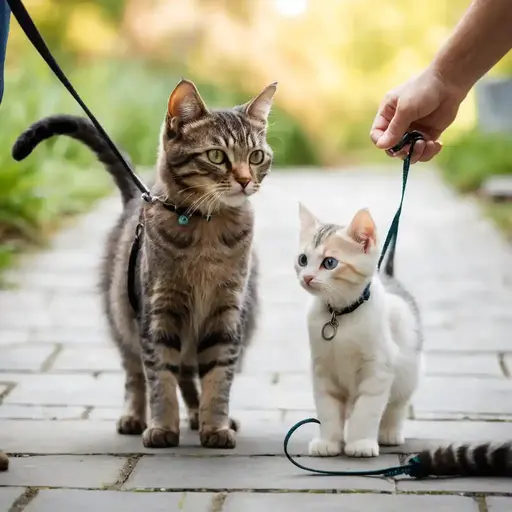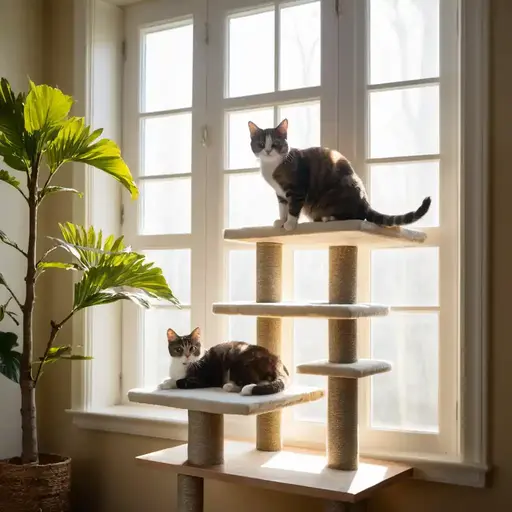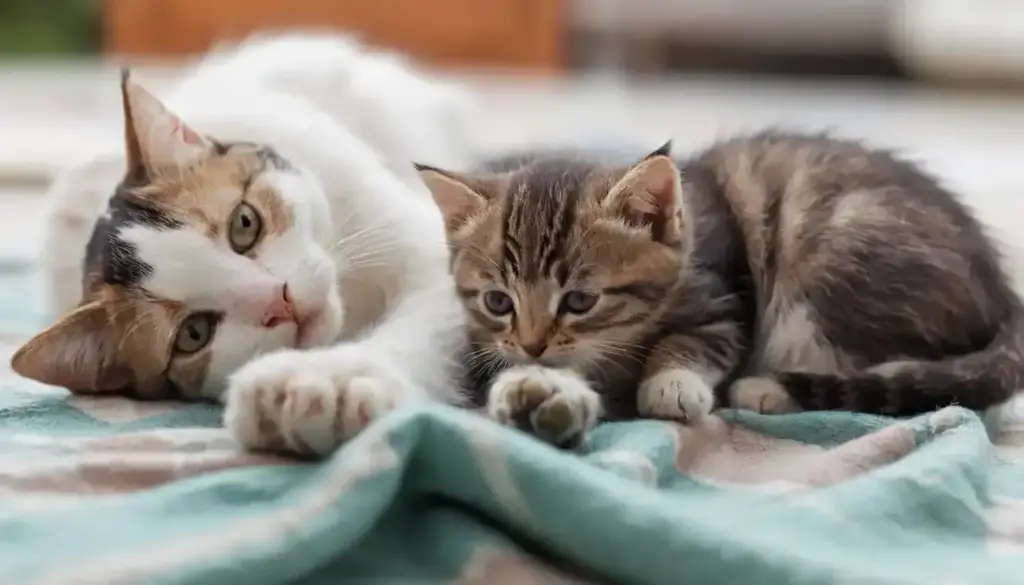Welcoming a new kitten into a home with an older cat can feel like navigating a delicate dance—one misstep might lead to hisses, swats, or lingering tension.
Yet, with patience and the right approach, this transition can blossom into a harmonious relationship that enriches your entire household.
A thoughtful introduction isn’t just about avoiding conflict; it’s about laying the groundwork for trust, companionship, and shared joy.
Why a Harmonious Multi-Cat Household Matters
- Reduced Stress: Cats thrive in predictable environments. A calm, gradual introduction minimizes anxiety for both pets.
- Lasting Bond: Properly introduced cats often form playful, affectionate relationships, turning solitude into shared adventures.
- Peace of Mind: A conflict-free home allows everyone—human and feline—to relax and enjoy each other’s company.
This guide walks you through how to introduce a new kitten to an older cat, offering expert strategies to ensure a smooth and stress-free transition for both pets.
You’ll discover actionable steps—from scent swapping to supervised interactions—alongside troubleshooting tips for common challenges like territorial disputes or jealousy.
Beyond the basics, we delve into fostering long-term connections, ensuring your cats don’t just coexist but truly thrive together.
By blending empathy with proven techniques, this process becomes less about “training” and more about nurturing a language of mutual respect. Let’s transform curiosity into camaraderie, one paw step at a time.

Understanding Cat Behavior During Introductions
Cats, by nature, are both solitary survivors and meticulous territorial guardians.
Unlike dogs, who often greet newcomers with wagging tails, cats interpret unfamiliar scents and sounds as potential threats to their domain.
This instinctual wiring explains why introducing cats can feel like negotiating a truce between rival diplomats.
Territorial Instincts: More Than Just “Jealousy”
- Cats mark their territory through scent glands on their paws, cheeks, and tails, creating invisible boundaries. A new kitten’s presence disrupts this carefully curated map, triggering stress responses in resident cats.
- Older cats may perceive kittens as chaotic intruders, while kittens might misinterpret calm senior cats as aloof playmates.
Decoding Feline Communication
Hissing, growling, or swatting aren’t signs of “spite” but primal survival tools. These behaviors communicate discomfort, not malice. Key signals to observe:
- Normal Adjustments: Brief hisses, cautious avoidance, or mutual sniffing.
- Red Flags: Prolonged aggression, relentless chasing, or refusal to eat/drink.
The Psychology Behind the Struggle
Cats lack the social flexibility of humans or dogs. Their relationships develop slowly, rooted in scent familiarity and spatial respect.
Forcing interactions accelerates stress; patience allows trust to grow organically.
A kitten’s playful leaps might overwhelm a senior cat, while an older cat’s stern swats are attempts to establish boundaries, not rejection.
By viewing these behaviors through a lens of instinct rather than emotion, caregivers can respond with empathy.
The goal isn’t to “fix” their reactions but to create a shared language of safety and mutual respect.
Preparation Before Bringing the Kitten Home
The days before the kitten arrives are critical for setting the stage for a peaceful integration.
Just as you’d prepare a nursery for a newborn, creating a structured environment tailored to feline instincts can prevent misunderstandings and ease tension.
Safe Space: A Sanctuary for the Newcomer
Designate a quiet room as the kitten’s headquarters, away from the older cat’s favorite spots. Equip it with:
- Essentials: A litter box, food/water bowls, cozy bed, and toys.
- Vertical Escape: A cat tree or shelf allows the kitten to retreat from perceived threats.
Scent Introduction: Building Familiarity
Cats “meet” through scent long before physical interaction. Place a blanket or toy carrying the kitten’s scent in the older cat’s area, and vice versa. This gradual exchange reduces territorial shock.
Supplies: Preventing Resource Competition
Adopt the “one per cat plus one” rule for litter boxes, feeding stations, and scratching posts. Extra resources minimize rivalry and signal abundance.
Calming Aids: Easing Emotional Turbulence
- Pheromone Diffusers: Feliway mimics natural calming pheromones, reducing anxiety in both cats.
- Supplements: L-theanine or vet-approved treats can soothe nervous systems.
Health Check: Safeguarding the Household
Schedule a vet visit for the older cat to confirm vaccinations and test for FeLV/FIV. A healthy resident cat is better equipped to handle stress.
Checklist for Success
- Kitten-proofed safe room with vertical spaces
- Scent-swapped items (blankets, toys)
- Extra litter boxes and feeding stations
- Calming diffusers installed in shared spaces
- Vet records reviewed for both cats
By prioritizing preparation, you transform your home into a neutral zone where curiosity can flourish without pressure.
Vertical territories—like wall-mounted shelves or multi-level cat trees—also offer cats alternative pathways to avoid face-to-face confrontations, fostering independence and mutual respect.

The First Few Days: Keeping Them Separate
The initial separation phase isn’t about isolation—it’s about cultivating familiarity through controlled exposure.
Think of it as a silent dialogue between cats, where scents and sounds lay the groundwork for future friendship.
Safe Space Dynamics
- Kitten’s Sanctuary: Keep the kitten confined to their designated room, ensuring they have access to essentials like food, water, and a litter box.
- Older Cat’s Freedom: Allow the resident cat to explore the rest of the home, reinforcing their sense of security.
Scent Swapping: The Invisible Introduction
Exchange bedding or towels between the cats daily, focusing on items rubbed against their faces (where scent glands cluster).
This mimics how cats naturally investigate newcomers in the wild. Observe reactions:
- Curiosity: Sniffing, soft purring, or kneading the fabric.
- Stress: Hissing, flattened ears, or avoidance.
Decoding Body Language
A cat’s posture reveals volumes about their emotional state:
- Relaxed Posture: Slow blinking, tail loosely curled—signs of calm curiosity.
- Threat Signals: Puffed tail, arched back, or growling indicate discomfort.
- Playful Ambiguity: A kitten’s “zoomies” might overwhelm a senior cat, while a senior’s swat could be a boundary-setting gesture, not hostility.
Progress Checkpoints
- Day 1–3: Focus on scent swapping; avoid physical meetings.
- Day 4+: Introduce auditory cues (e.g., mealtime near the door) to build positive associations.
By respecting this phased approach, you honor both cats’ need for autonomy.
The goal isn’t to rush harmony but to let trust germinate organically, like planting seeds in fertile soil and waiting for the first sprout.
Gradual Introduction: First Visual Contact
The moment your cats see each other marks a pivotal step in their relationship—a fragile alliance forged through cautious curiosity.
Like diplomats meeting across a neutral border, this phase requires careful orchestration to ensure neither cat feels cornered or threatened.
Visual Contact Setup
Use a baby gate, mesh screen, or crate to allow supervised, non-physical interactions. Position their resources (food bowls, litter boxes) on opposite sides of the barrier to maintain a stress-free zone.
Body Language: The Silent Negotiation
Observe both cats closely during these sessions:
- Positive Signs: Slow blinking, relaxed tails, or playful “chattering”.
- Stress Indicators: Dilated pupils, flattened ears, or stiff postures.
Rewarding Calmness
- Toss treats or offer praise when either cat remains composed.
- Use mealtime or play sessions near the barrier to build positive associations.
Territorial Tendencies: When to Slow Down
If the older cat fixates on the kitten or exhibits prolonged hissing, pause and reintroduce scent-swapped items.
Consider adding calming aids like Feliway diffusers to ease territorial anxiety.
Progression Timeline
- Days 1–3: Short, 5–10 minute sessions with high-value treats.
- Days 4+: Gradually extend time if both cats stay relaxed.
Checklist for Visual Success
- Barrier securely in place
- Treats and toys on hand for reinforcement
- Calming aids are activated in shared spaces
By honoring their need for gradual connection, you’re not just introducing cats—you’re teaching them a new language of coexistence.
Every flick of a tail or shared meal is a step toward rewriting their story from strangers to housemates.

Supervised Face-to-Face Meetings
The first physical encounter between your cats is akin to a carefully choreographed ballet—each movement must be deliberate, measured, and ready to pause at a moment’s notice.
This phase bridges the gap between curiosity and trust, turning guarded glances into tentative alliances.
Setting the Stage for Success
- Short Sessions: Begin with 5–10 minute meetings, using a leash or harness for the kitten to maintain control.
- Neutral Territory: Choose a space neither cat “owns,” like a living room, to reduce territorial claims.
Positive Reinforcement: Building Bridges
- Reward calm interactions (sniffing, relaxed postures) with treats, praise, or gentle play.
- Use a consistent cue like “good cats” to associate their behavior with approval.
Managing Energy and Aggression
- kitten Antics: Tire the kitten with solo play before meetings to curb overwhelming energy.
- Red Flags: Separate cats immediately if hissing escalates, fur flies, or one cat freezes.
Handling Setbacks
If the older cat displays prolonged tension:
- Resume scent swapping or visual contact for 1–2 days.
- Add calming aids like lavender sprays or quiet background music.
Checklist for Supervised Sessions
- Leash/harness for the kitten
- High-value treats and toys on hand
- Calming aids are in place
- Exit strategy for quick separation
Every interaction, no matter how brief, is a step toward rewriting their dynamic.
By prioritizing patience and celebrating small victories, you’re not just introducing cats—you’re nurturing a shared language of coexistence.
Full Integration: Allowing Unsupervised Time
The final phase of integration is like removing training wheels—exciting but requiring careful judgment.
This milestone isn’t about speed but about recognizing when both cats consistently signal acceptance through relaxed body language, shared spaces, and mutual tolerance.
Signs of Readiness
- Consistent Calm: No hissing, swatting, or resource guarding for at least 7–10 days.
- Shared Spaces: Cats coexist in the same room without fixating on each other.
Resource Management for Harmony
Even in harmony, cats crave individual ownership:
- Feeding Stations: Separate bowls in distinct areas prevent mealtime tension.
- Litter Boxes: Follow the “one per cat plus one” rule, and place in low-traffic zones.
- Resting Zones: Designate high perches or cozy hideaways for each cat.
Vertical Territories: The Power of Elevation
Install cat trees or wall-mounted shelves to give the older cat escape routes.
Vertical spaces reduce territorial disputes by offering alternative pathways and vantage points, a strategy endorsed by feline welfare experts.
Long-Term Bonding Strategies
- Group Play Sessions: Use wand toys or laser pointers to encourage cooperative play.
- Routine Check-Ins: Monitor interactions weekly to ensure no lingering stress resurfaces.
Checklist for Unsupervised Success
- Separate feeding/litter areas are maintained
- Vertical escape routes installed
- Daily group play is incorporated
By respecting their need for autonomy while nurturing shared experiences, you transform coexistence into companionship—a multi-cat household where every feline feels secure, valued, and connected.

Troubleshooting Common Issues
Even with meticulous planning, cats may test boundaries or struggle to adapt.
Think of these challenges not as failures but as opportunities to refine your approach, like adjusting a recipe until it’s just right.
Persistent Hissing: Patience Over Pressure
If hissing continues beyond initial introductions, it’s a signal to slow down.
Revert to scent swapping or visual contact, and reintroduce calming aids like Feliway. Avoid forcing interactions; cats need time to rewrite their territorial narratives.
Kitten Play Aggression: Channeling Chaos
A kitten’s playful swats can escalate stress for older cats. Redirect this energy with wand toys or puzzle feeders before meetings . For declawed older cats, prioritize gentle play to avoid discomfort.
Stress Signals: When to Pause
Watch for:
- Changes in eating, litter habits, or excessive grooming.
- Withdrawal or aggression from the older cat.
If these persist, consult a vet to rule out health issues or enlist a feline behaviorist.
Special Considerations
- Declawed Cats: Use soft toys to prevent pain during play.
- Special-Needs Cats: Adjust timelines—blind or arthritic cats may need quieter, slower introductions.
Checklist for Resolution
- Resume scent swapping if hissing persists
- Schedule a vet check for stress-related health changes
- Adjust playtime to match energy levels
By addressing issues with empathy and flexibility, you transform friction into understanding.
Remember, every setback is a step toward deeper harmony—proof that even the most cautious cats can learn to share their world.
Long-Term Harmony and Bonding
Cultivating a harmonious multi-cat household is like tending a garden—it requires ongoing care, observation, and adaptability.
Even after the initial introduction phase, nurturing relationships ensures roots of trust grow deeper, transforming tolerance into lasting companionship.
Building Bonds Through Shared Experiences
- Interactive Play: Use feather wands or laser pointers to engage both cats simultaneously, fostering teamwork and positive associations.
- Cooperative Feeding: Place food bowls near each other (but not too close) to reinforce shared mealtime calm.
Subtle Signs of Strain
Monitor for quiet conflicts:
- Resource Guarding: One cat lingering near food/water bowls or litter boxes to intimidate.
- Passive Aggression: Staring, blocking pathways, or “accidental” swats.
Real-Life Success: From Rivals to Roommates
A reader shared how her 8-year-old tabby, Miso, initially hissed at kitten Kona for weeks.
By dedicating 10 minutes daily to joint play and adding vertical shelves, Miso now tolerates Kona’s antics—and even grooms her during sunbathing sessions.
Respecting Boundaries
Not all cats will cuddle, and that’s okay. Some thrive as “friendly neighbors” rather than soulmates. Signs of peaceful coexistence include:
- Parallel lounging.
- Mutual avoidance of conflict.
Checklist for Lasting Harmony
- Schedule weekly group play sessions
- Audit resource placement monthly
- Watch for shifts in social dynamics
By blending vigilance with flexibility, you create a home where every cat feels secure—a sanctuary where even silent truces are celebrated as victories.
Conclusion
Like nurturing a garden, fostering harmony between a kitten and an older cat requires patience, attention, and trust in the process.
Every hiss, curious sniff, or shared sunbeam is a chapter in their evolving story—a narrative shaped by your dedication to their well-being.
Key Steps Recap
- Preparation: A sanctuary for the kitten, scent swapping, and resource abundance lay the foundation.
- Gradual Introduction: Visual contact, supervised meetings, and vertical spaces ease territorial tensions.
- Integration: Unsupervised freedom is granted only when mutual calm is consistent.
- Troubleshooting: Addressing setbacks with empathy and flexibility.
Patience: The Unseen Tool
Success isn’t measured in days but in small victories—a shared meal, a tolerated nap nearby, or a playful paw flicked without malice. Progress may take weeks or months; forcing timelines risks unraveling trust.
Continue Learning
For deeper insights, explore trusted resources:
Every cat relationship is unique. Whether your cats become inseparable companions or cordial housemates, the goal is a home where all feel safe to thrive. Keep observing, adapting, and celebrating their quirks—after all, peace is built one paw step at a time.
FAQ
How long does it take for cats to get along?
Cats operate on their own timeline—some form bonds in 2–3 weeks, while others need months.
Factors like personality, past experiences, and the introduction process influence this.
Older cats, especially, may resist change due to established territorial habits. Celebrate small wins: a shared nap spot or calm meal together signals progress.
Can I introduce multiple kittens at once?
While tempting, introducing multiple kittens simultaneously can overwhelm an older cat.
Start with one kitten, following the gradual process outlined earlier. Once harmony is achieved, consider adding another if desired. This prevents sensory overload and reduces territorial stress.
What if my older cat is declawed or has special needs?
Adjust the process to accommodate their needs:
- Declawed Cats: Use soft toys and avoid rough play to prevent discomfort.
- Arthritic/Blind Cats: Slow the timeline, prioritize quiet spaces, and consult your vet for tailored advice.
- Health Checks: Ensure both cats are medically cleared to rule out pain-induced aggression.
Why does my older cat ignore the kitten?
Indifference is normal! Many cats coexist peacefully without overt affection. Focus on low-stress routines and shared positive experiences (e.g., mealtime proximity) to nurture quiet camaraderie.
Checklist for Special Scenarios
- Adjust playtime for declawed/senior cats
- Consult a vet for health or mobility concerns
- Prioritize one-on-one bonding before adding more pets
By addressing these questions with empathy and flexibility, you tailor the process to your unique household—a cornerstone of lasting feline harmony.



